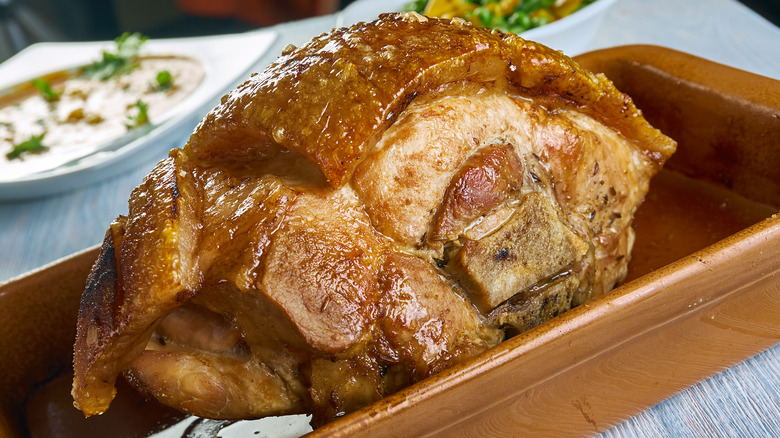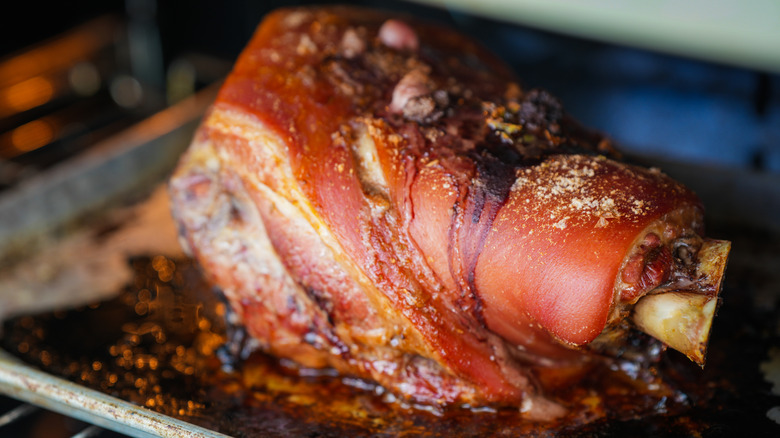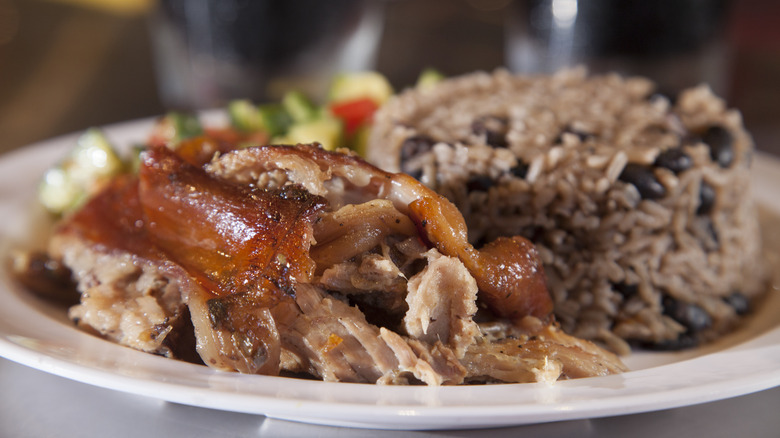What Cut Of Meat Is Pernil?
Pernil is a delicious Puerto Rican dish typically served around the holidays but can be made for any special occasion. It's a large roast, so it is ideal for feeding a crowd — or for sneaking leftovers. It takes a while to make, between marinating and roasting time, but the effort is well worth it for the succulent meat and crispy skin on the table.
Pernil is usually made with an on-the-bone, fat-capped pork shoulder or picnic roast marinated for up to three days in a citrusy, garlicky marinade before being roasted or grilled slowly over a high heat. It's deeply caramelized and dripping in its juices from the slow cook. Toward the end of roasting, the heat is turned up so the skin becomes crispy, and the meat is juicy and falling-apart tender — it's hard to resist having a bite. It's served in a few ways, whether it's with rice and beans and a squeeze of lime juice or served as a taco with quick pickled red onions and a dusting of cilantro and lime juice.
For the best pernil asado, fat matters
Why pork shoulder and not a different cut of pork, like a belly or loin? It's all in the fat. Pork belly has a large amount of fat, ideal for slow roasting. But a pork shoulder is best for steeping in a marinade and creating the star of the dish: the crackling. It's cheaper, too, so kinder to your wallet when feeding a crowd. The shoulder is full of connective tissue and fat, so look for veins and marbling when picking out a pork shoulder for the best results. During a slow roast, all the cartilage and fat breaks down, drenching the joint in fat and keeping the meat moist. If a pork shoulder is undercooked, it'll be tough and chewy and won't pull apart because the connective tissues between the muscle fibers won't have broken down. Time is essential for getting a tender pork shoulder that falls apart at the mere sight of a fork.
The bonus is the fat cap on the pork shoulder, which renders down beautifully and, for a pernil, gets crispy from the time spent in the heat or at the end of cooking under the broiler. This ensures you get the best of both worlds: A bit of succulent pork shoulder with crispy, salty cuerito (skin).
Pernil at home requires time but it's well worth it
You can make your own pernil asado in the oven, on the grill, or even in a slow cooker. You'll need some space in the refrigerator for the marinating time, but it's achievable. Try to find a pork shoulder with plenty of skin and fat on top. Aim for around 10 pounds for five servings, as the shoulder will lose half its weight during the roast. If you can't find a larger cut, you can split the marinade or double it to spread over another pork shoulder.
Your pork shoulder should be marinated with a quick and easy sofrito, a foundational ingredient in Puerto Rican cuisine. To solve the problem of flavor not penetrating through the sheer size and mass of the pork shoulder, make small cuts in the meat and massage the marinade into the slits. You can even poke some smashed garlic cloves in there for bonus flavor. Marinate the pork at least overnight or for up to three days. Roast the meat in the oven at 325 degrees Fahrenheit for 30 to 35 minutes per pound. But for pernil, don't cook to temperature. (Of course, make sure it's food-safe with a digital thermometer at the thickest part. For pork, FoodSafety.gov says the internal temperature should reach 145 degrees Fahrenheit.) What you're ultimately looking for in pernil is a visual and textural cue — if the meat is tender and breaks apart easily, it's ready to serve.


